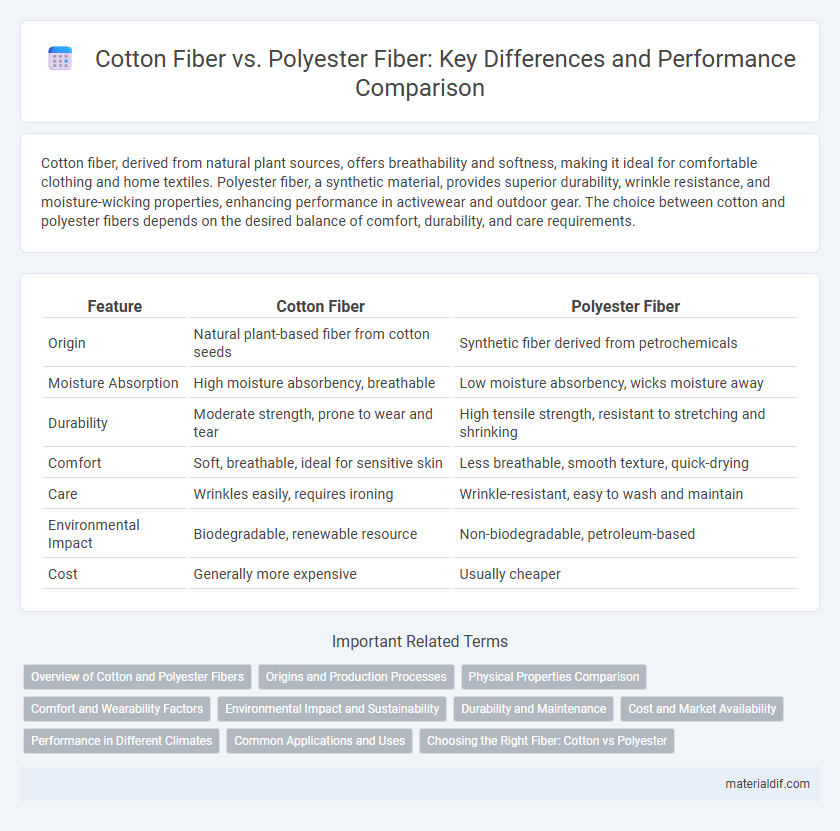Cotton fiber, derived from natural plant sources, offers breathability and softness, making it ideal for comfortable clothing and home textiles. Polyester fiber, a synthetic material, provides superior durability, wrinkle resistance, and moisture-wicking properties, enhancing performance in activewear and outdoor gear. The choice between cotton and polyester fibers depends on the desired balance of comfort, durability, and care requirements.
Table of Comparison
| Feature | Cotton Fiber | Polyester Fiber |
|---|---|---|
| Origin | Natural plant-based fiber from cotton seeds | Synthetic fiber derived from petrochemicals |
| Moisture Absorption | High moisture absorbency, breathable | Low moisture absorbency, wicks moisture away |
| Durability | Moderate strength, prone to wear and tear | High tensile strength, resistant to stretching and shrinking |
| Comfort | Soft, breathable, ideal for sensitive skin | Less breathable, smooth texture, quick-drying |
| Care | Wrinkles easily, requires ironing | Wrinkle-resistant, easy to wash and maintain |
| Environmental Impact | Biodegradable, renewable resource | Non-biodegradable, petroleum-based |
| Cost | Generally more expensive | Usually cheaper |
Overview of Cotton and Polyester Fibers
Cotton fiber, derived from the cotton plant, is a natural cellulose fiber known for its softness, breathability, and biodegradability, making it ideal for comfortable and eco-friendly textiles. Polyester fiber, a synthetic polymer made from petrochemicals, offers superior durability, moisture-wicking properties, and resistance to wrinkles and shrinking, commonly used in performance and long-lasting apparel. Both fibers dominate the textile industry, with cotton favored for natural comfort and polyester chosen for strength and versatility.
Origins and Production Processes
Cotton fiber originates from the natural seed hairs of the cotton plant, harvested and processed through ginning, carding, and spinning to produce soft, breathable textile fibers. Polyester fiber is a synthetic fiber derived from petrochemical sources, primarily polyethylene terephthalate (PET), produced through a polymerization process followed by melting and extrusion into continuous filaments. The natural origin and biodegradable nature of cotton contrast with the energy-intensive production and durability of polyester, influencing their applications and environmental impact in the textile industry.
Physical Properties Comparison
Cotton fiber exhibits high moisture absorbency, breathability, and softness, making it comfortable for wear in warm climates, while polyester fiber provides superior tensile strength, elasticity, and wrinkle resistance. Cotton fibers have a lower melting point and degrade under prolonged exposure to sunlight, whereas polyester fibers offer enhanced durability and UV resistance. The natural cellulose composition of cotton results in lower static buildup compared to the synthetic polymer structure of polyester.
Comfort and Wearability Factors
Cotton fiber offers superior breathability and moisture absorption, providing enhanced comfort during prolonged wear, making it ideal for sensitive skin and hot climates. Polyester fiber excels in durability and wrinkle resistance, maintaining shape and color after multiple washes, which supports long-term wearability. The choice between cotton and polyester fibers hinges on prioritizing natural softness and temperature regulation versus resilience and low maintenance.
Environmental Impact and Sustainability
Cotton fiber, being a natural and biodegradable material, generally has a lower environmental impact compared to polyester fiber, which is synthetic and derived from petroleum-based resources. However, cotton cultivation requires significant water, pesticides, and land, raising concerns about sustainability in large-scale production. Polyester fiber's durability and recyclability offer some eco-friendly benefits, but its non-biodegradable nature contributes to microplastic pollution and long-term waste issues.
Durability and Maintenance
Cotton fiber exhibits moderate durability but tends to wear out faster than polyester fiber due to its natural composition, which is more susceptible to abrasion and environmental factors. Polyester fiber offers superior durability, resisting stretching, shrinking, and wrinkling, which makes it ideal for long-lasting applications. Maintenance of cotton fabric requires careful washing and drying to prevent damage, whereas polyester is low-maintenance, with excellent resistance to stains and moisture, allowing easier cleaning and longevity.
Cost and Market Availability
Cotton fiber generally costs more than polyester fiber due to its natural origin and labor-intensive cultivation process, while polyester benefits from lower production costs as a synthetic material. Polyester fiber dominates the global market with broader availability and consistent supply, driven by large-scale industrial manufacturing. Cotton fiber, although less available in certain regions, maintains steady demand for its breathability and natural properties despite seasonal and climate-related fluctuations.
Performance in Different Climates
Cotton fiber excels in hot and humid climates due to its high breathability and moisture absorption, providing superior comfort by allowing air circulation and sweat evaporation. Polyester fiber performs better in cold and wet conditions as it resists water absorption, dries quickly, and retains warmth even when damp. The choice between cotton and polyester fibers depends heavily on the climate, balancing natural cooling properties against synthetic durability and moisture resistance.
Common Applications and Uses
Cotton fiber is widely used in apparel, home textiles, and medical supplies due to its breathability, softness, and moisture absorption properties. Polyester fiber, known for its durability, wrinkle resistance, and quick-drying ability, is commonly applied in activewear, upholstery, and industrial fabrics. Both fibers are integral in blended textiles to combine comfort from cotton and resilience from polyester, optimizing performance in various products.
Choosing the Right Fiber: Cotton vs Polyester
Cotton fiber offers breathability, softness, and natural moisture absorption, making it ideal for comfort-focused clothing and sensitive skin. Polyester fiber provides durability, resistance to wrinkles and shrinking, and quick-drying properties, suited for activewear and long-lasting textiles. Selecting cotton versus polyester depends on the desired balance between natural comfort and synthetic performance in fabric applications.
Cotton fiber vs Polyester fiber Infographic

 materialdif.com
materialdif.com